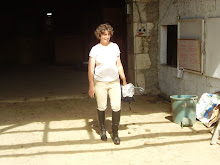In the traditional textbooks there is always a chapter on telling time. An explanation followed by examples and very often clock faces even though today's children are more likely to have digital watches. How do we teach time with TPRS?
To begin, there is no chapter on telling time, just as there is no chapter on the weather, or clothes, or body parts or colors or sports or animals, etc. Putting all the vocabulary concerning a specific theme in one chapter insures that it will be forgotten as soon as the chapter test is over. Those who use TPRS introduce the vocabulary as it is needed for stories, just as children learn the words for hands, feet, dog, cats, raining, mittens, etc. as the need appears. A TPRS teacher will spread the vocabulary from one thematic chapter out over the entire year, teaching the more frequent words first and adding on the others as the opportunity comes.
It is very easy to teach time, even to young pupils. We simply ask when something happens. There is a boy. Where does he live? In Missouri, the students say. The boy who lives in Missouri sees a girl with green hair. When does he see the girl? In the morning or in the afternoon? In the morning.
Once the students have acquired morning and afternoon, we can introduce day and night. These are quickly and easily acquired as long as the teacher thinks to ask the question "When?" as often as possible. Then she can start asking for the time in hours. In her stories it is always one o'clock or six o'clock or eight o'clock. For the moment, the clocks in her stories have no minute hands.
Once her students are saying that the boy went to school at eight o'clock and the class finished at five o'clock without any hesitations, she can introduce half hours. When did the dog jump out of the window? At half past ten. At ten thirty. The two expressions can be presented at the same time as being equivalent. Students will immediately grasp ten thirty and recognize half past ten as meaning the same thing, if they hear the teacher saying both expressions, one after the other.
I've noticed that my traditionally taught French students often confuse "half past" and "a quarter past", simply because the expressions were taught in the same lesson at the same time, along with "a quarter to". So I can hear things like "half to five". And neither I nor the student know whether he means four thirty or five thirty. By being sure that "half past" is acquired, which means being used spontaneously, without thinking, before we introduce "a quarter past", we can avoid that confusion.
And I also hold off on "a quarter to", for the same reason. Let the concept of a quarter past the hour be solidly acquired before we introduce the idea of "a quarter to" the hour. Our patience and restraint will be generously rewarded, because once they have grasped the meaning of "a quarter to" we can easily introduce minutes and the rest is all downhill.
By introducing the expressions of time gradually, over the course of a year, we will insure that our students are able to tell the time accurately and will understand when they are told the time. In other words, when teaching expressions of time, it's necessary to take your time.

2 comments:
Good to hear that again. And funny that just today I did the whole old shebang of teaching all time words together in one spot. I then wanted to personalize it, but I guess I'll take a step back and just use the hours and half hours (time was introduced in primary school).
Thanks for the reminder.
Don't forget to include times in your readings. It's easier for the student to read the TL time and then figure it out in his first language, than to produce time in the TL.
Post a Comment